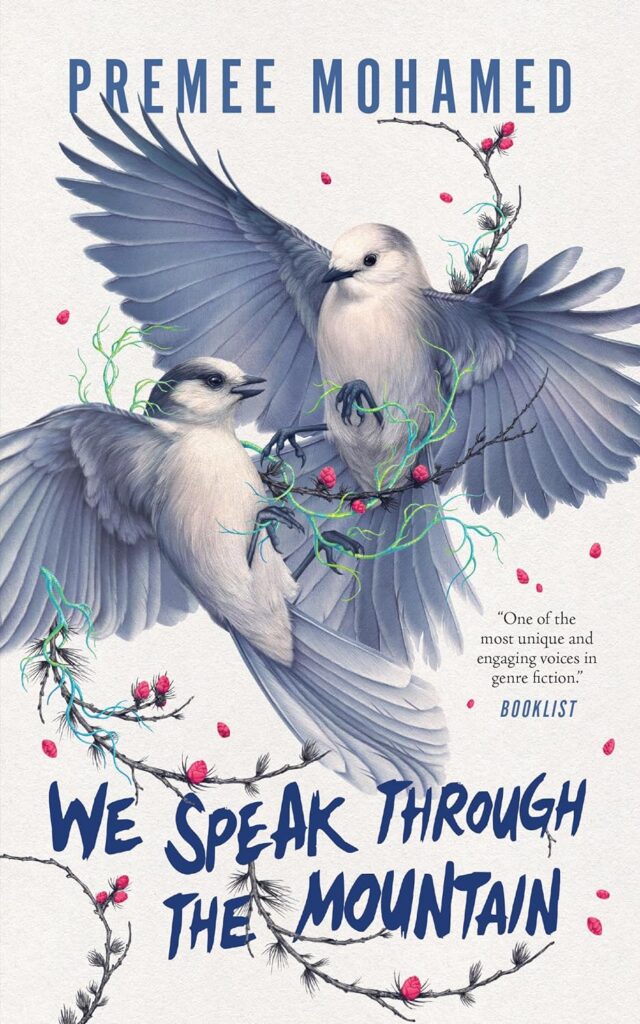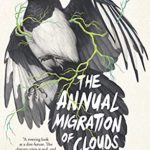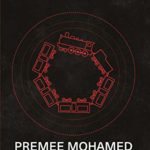We Speak Through the Mountain by Premee Mohamed is the second part of the story she began a couple of years ago in The Annual Migration of Clouds. It’s another strong novella that continues the story of nineteen year-old Reid, surviving in a post-apocalyptic western Canada. The story picks up directly from where the last one left off so I’ll sketch that background to give a few essential facts, though you could get them from context if you haven’t read the earlier novella.
Reid, with her family, friends and a small community, have survived the ruin of earth (though we’re not told exactly what happened) on a university campus. Most of the natural world has been poisoned, buildings collapsed, the population drastically cut down, but there a few surviving communities, like Reid’s, where the people have learned to make use of everything at hand to stay alive. But everyone has been infected with an incurable disease that’s like a parasite growing in flesh until it kills the host. Its visible branching tree-like formations are the visible sign of the illness, and it is thriving in Reid. There are said to be isolated domed communities that preserve more advanced technology and have learned to overcome the illness, called Cad. One day Reid receives an invitation to join one of these, and The Annual Migration of Clouds takes the story to the moment when Reid is giving up her old life and starting on the journey to a new one.
We Speak Through the Mountain opens with Reid badly injured and nearly delirious on a mountain as she’s struggling to reach the university community called Howse. She has a tracker that will send a signal when she is getting close. A party of Howse security will then go out to find her to take her the rest of the way. Just as she is collapsing, hands grab her, she is sedated and wakes up inside her new community. The sedation is designed to keep any outsider from learning the full route to Howse so it can avoid being overrun by “them”. This is Reid’s introduction to being “othered.” Once awake, she finds that everyone lives alone in well-appointed rooms and are supplied with the same style and color of clothes. Each room has its own food center that creates whatever is wanted.
Reid can’t bear the idea of living completely alone and finds another outsider, Clementine, to talk to. They ask long-time residents about a dining hall and are met with blank stares – eating together is just not done in Howse. Worse still, Reid is mocked by one man, who finds it delightful to hear the ideas “you people” come up with. It’s like hearing a talking dog, he says. When Reid tries to create a club dedicated to sharing things with outsiders, none of the insiders at Howse can comprehend the idea, and it goes against policy to have contact with the survivors outside the domes. They don’t want just anyone to find out their exact location and be able to get inside.
Even more basic to the idea of life at Howse is the forgetting of the past. Everyone talks only about the future, as if they had nothing to do with the previous destruction of the world around them. Yet, for Reid, acknowledging the past is central to her vision of the future, for knowing how productive the old technology was, as well as its destructive power, offers guidance to a better future where earlier mistakes can be avoided while the best of the old knowledge can help rebuild life. But the Howse administration will have none of that. They have their own technological marvels and want to keep progressing on their terms, eyes only on the future. Individuals think of themselves as assets, growing or diminishing in value, always in the future.
They do have a treatment for Cad, and Reid receives this as soon as she arrives. It only puts the disease in remission, at this point in its development, so she needs to keep getting periodic shots. But the branching tree structures she used to see in the surface of her skin retreat and become invisible, though she knows they are still lurking under the surface and can return if she stops the treatment for any reason.
These ideas, and Reid’s angry reactions, come together in a beautiful scene when Reid visits a museum devoted to technological advances. There she finds Cardinal, president of the university, staring intently at a display case that houses only an old paper notebook. She explains to Reid that this is the notebook with the original insights of one researcher that led to the breakthrough in the treatment of Cad. Reid focuses on the fact that any references to its date have been removed, and she speculates that perhaps it’s because a date would reveal that they had this treatment before the collapse of the outside, that they might have used it to save millions and to mitigate the catastrophe. She roils at the thought that they kept this knowledge hidden and still refuse to spread their technology to the outside world. Erasing references to the past and thinking only in terms of the future helps the insiders pretend they have no responsibility to anyone but themselves.
Reid is an impulsive rule-breaker. Her irresistible curiosity leads her at one point to test the permeability of the invisible barrier that separates Howse from the outside. In a short time, she manages to test every limit she runs into, usually helped by Clementine as well as by St. Martin, an insider who has emotions for Reid he can’t recognize as love. As her transgressions get bolder, she uncovers more secrets of Howse and gains help from unlikely sources. The ending of this novella creates the set-up for a third book to carry on the story, though I haven’t heard anything about the next publication.
We Speak Through the Mountain packs in a lot of ideas about community, the exploitation of the natural world, colonization, othering but all of it wrapped into an interesting story about a young woman pushing all the boundaries for survival not only of herself but of the larger community. It’s memorable, exciting and so relevant to the tensions between the have’s and have not’s of today.





Leave a Reply